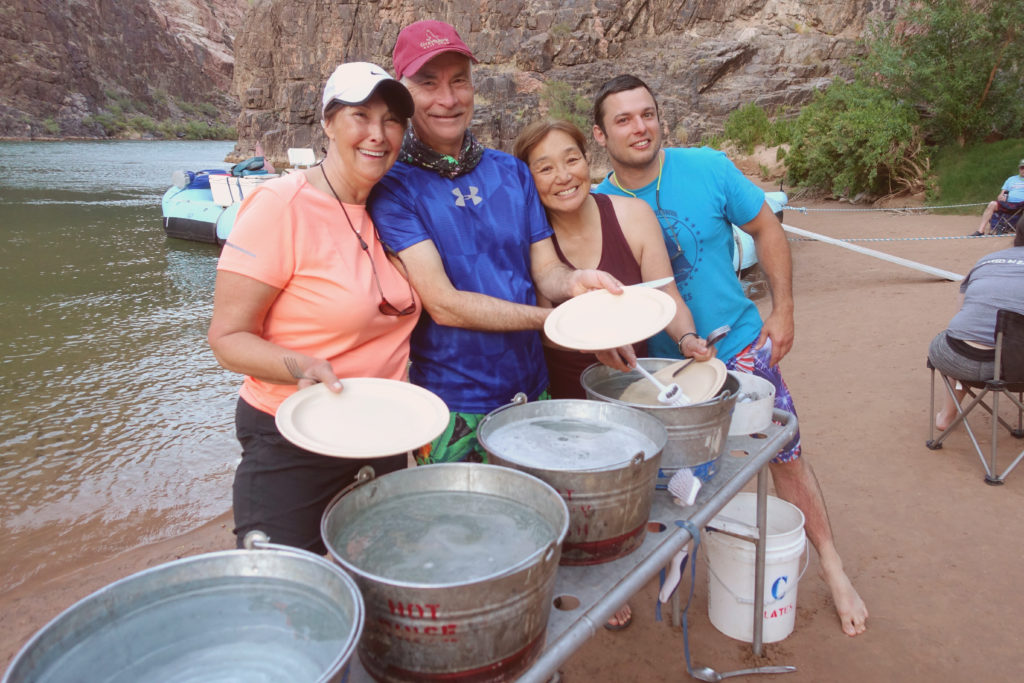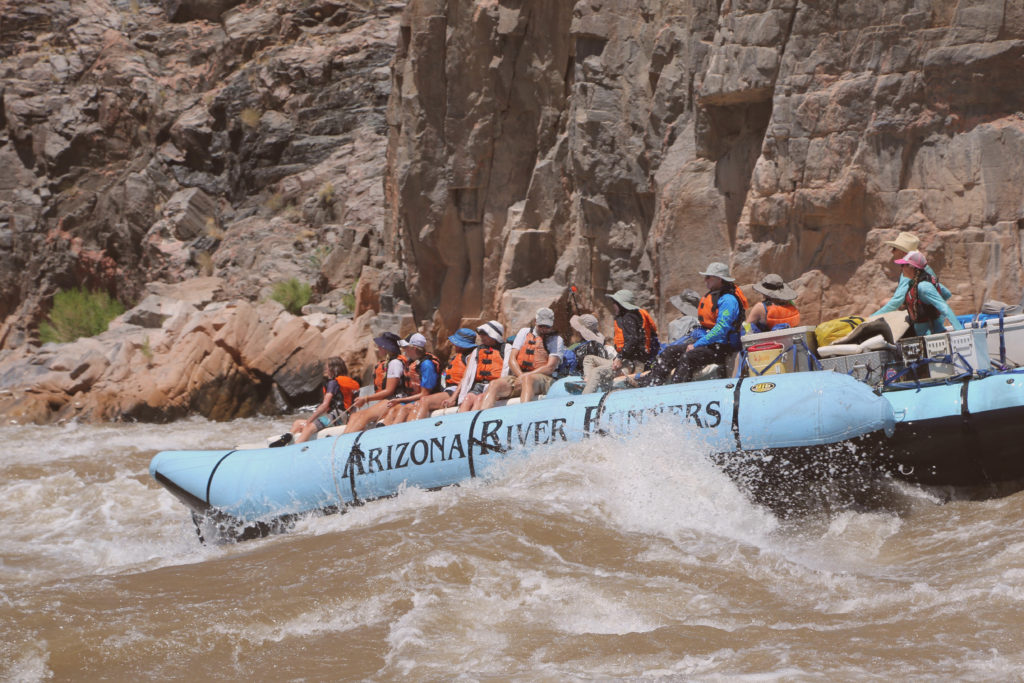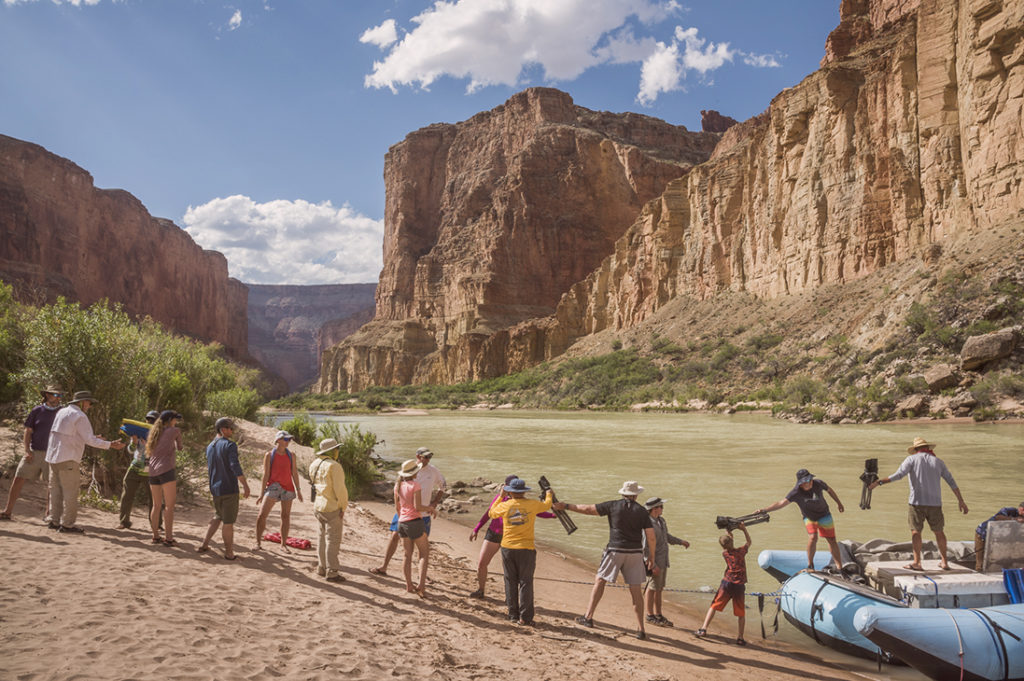Arizona River Runners / Trip Info – Trip Info Custom Itinerary
Trip Info: Custom Itinerary
Custom Itinerary
Your trip has a custom itinerary, so your group leader has created a PDF with details regarding meeting times, lodging, and other specialized items.
Click the pages listed above to view detailed information that is valuable for all of our river rafters – packing list, FAQs, and more! Read through it carefully. Reach out to us if you have any questions about your upcoming trip or need us to resend your itinerary.
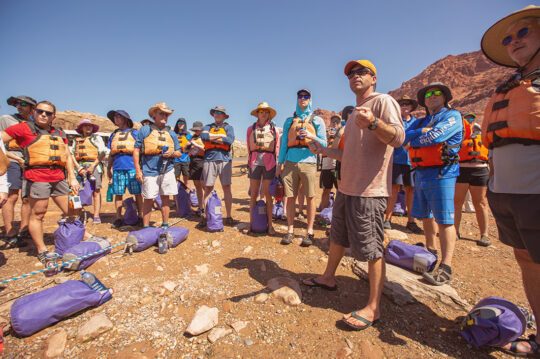
The packing list was created from decades of Grand Canyon rafting experience, please follow it (even a fleece in summer!). You will be traveling through remote wilderness areas with the possibility of extreme, unpredictable weather and large temperature swings. As your trip approaches, we recommend checking the weather in the canyon at Phantom Ranch. Follow the packing list below, and use the forecast to determine the need for extra warm or cold weather items. Remember, it is better to have and not need, than to need and not have. Being prepared goes a long way towards an enjoyable trip. For those of you flying to the area, we suggest carrying absolute river necessities in a carry-on bag. It is tough to get things together if your luggage is lost by the airline.
Note: Please limit your gear to 25 lbs; most need far less. If your trip includes a charter flight, baggage weight limits are enforced, but there are no liquid restrictions. DO NOT bring hard-sided luggage or suitcases on the river. Find many of these items in our online store and check out our blog for more insider info.
Required
Clothing
Optional Extra Items
Personal Items
What We Provide
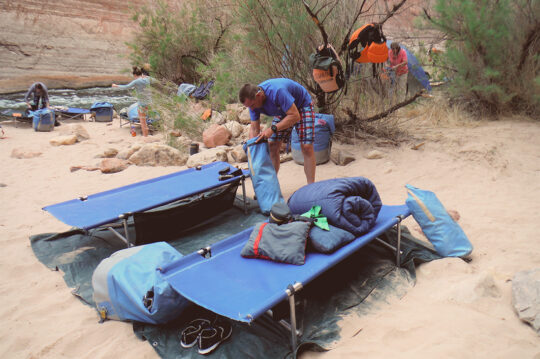
Grand Canyon rafting is a unique adventure. Once we embark into the canyon, we are self-sufficient and self-contained for the duration of the trip. This means packing well is important as there are no stores to supplement things you may have forgotten. We have put a great amount of thought and care into our packing list, and we ask that you trust our experience!
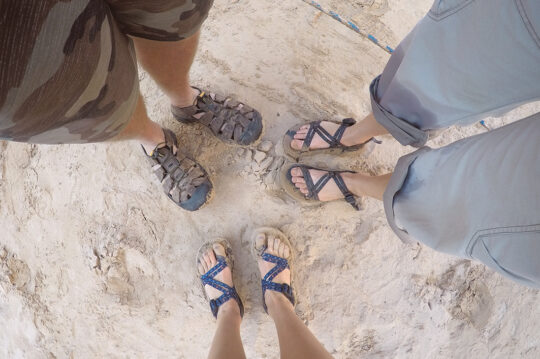 Investing in a good pair of river sandals/shoes is crucial to navigating the various slippery surfaces you’ll encounter. “Aqua socks” are not a good option. Getting on and off the rafts can be surprisingly challenging as the rafts are often moving and the side tubes can be extremely slippery. To help maneuver on these surfaces your river shoes should have grippy tread and attach securely to your foot with laces/straps. For optimal comfort make sure your shoes are broken in before the trip as you’ll be spending a majority of each day in these shoes. River sandals tend to be the most popular choice as they have all of these features and are great for the numerous side hikes on unmaintained backcountry trails which may be through water. Amphibious shoes are another good choice as they provide toe protection in addition to traction in both wet and dry conditions. We recommend Chaco, Keen, Bedrock, or Merrell for excellent river sandals/shoes.
Investing in a good pair of river sandals/shoes is crucial to navigating the various slippery surfaces you’ll encounter. “Aqua socks” are not a good option. Getting on and off the rafts can be surprisingly challenging as the rafts are often moving and the side tubes can be extremely slippery. To help maneuver on these surfaces your river shoes should have grippy tread and attach securely to your foot with laces/straps. For optimal comfort make sure your shoes are broken in before the trip as you’ll be spending a majority of each day in these shoes. River sandals tend to be the most popular choice as they have all of these features and are great for the numerous side hikes on unmaintained backcountry trails which may be through water. Amphibious shoes are another good choice as they provide toe protection in addition to traction in both wet and dry conditions. We recommend Chaco, Keen, Bedrock, or Merrell for excellent river sandals/shoes.
Ideally, you should bring 1 pair of river sandals/shoes, 1 pair of hiking or tennis/athletic shoes, 1 pair of flip-flops to wear in camp, and several pairs of socks. Your hiking shoes don’t need to fit in your duffel, they can be stored in the community shoe bag that will be accessible during the day. These hiking shoes are handy to switch into for longer, dry hikes. Most guests find hiking boots are too excessive, even for longer hikes. Flip-flops or Crocs are nice to bring so you can give your feet a break and switch out of wet, sandy river shoes once you’re at camp for the evening.
Watch out for blisters and sore spots due to rubbing and abrasive sand under the river shoe straps. Socks are a great way to help combat these issues, protect your feet from the sun, and keep them happy. Look for socks that are synthetic or wool instead of cotton. If you tend to run cold, wool socks can also help as they maintain heat when wet, or consider bringing neoprene booties/socks. Having proper footwear goes a long way towards an enjoyable trip!
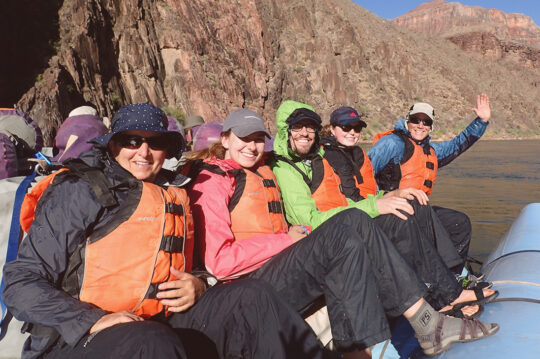 It is important to have a quality rain jacket with a hood and rain pants. Because the river is very cold year-round, you’ll use rain gear as a splash guard from the rapids. Even on the hottest days, guests often wear rain gear in the morning, while going through rapids, and in the shade of the canyon walls. Make sure your rain gear is waterproof, not just water-resistant. Rain gear with the ability to cinch at the neck and wrists works well. A poncho is not effective. Do NOT go on your river trip without rain gear!
It is important to have a quality rain jacket with a hood and rain pants. Because the river is very cold year-round, you’ll use rain gear as a splash guard from the rapids. Even on the hottest days, guests often wear rain gear in the morning, while going through rapids, and in the shade of the canyon walls. Make sure your rain gear is waterproof, not just water-resistant. Rain gear with the ability to cinch at the neck and wrists works well. A poncho is not effective. Do NOT go on your river trip without rain gear!
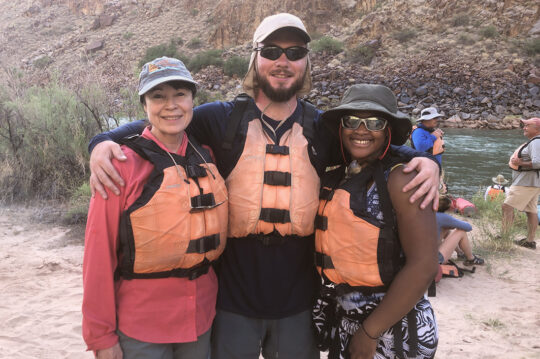 You will pack your duffel bag in our waterproof bags when you get to the river. Quick-drying clothing is highly recommended. Many of our guides wear long-sleeved shirts every day for sun protection. If it is overcast, it can turn chilly, so pack a fleece jacket to wear under your rain gear, no matter the time of year. You do not need a change of clothes for every day; many people wear the same outfit for several days. Follow the packing list and remember “less is more!”
You will pack your duffel bag in our waterproof bags when you get to the river. Quick-drying clothing is highly recommended. Many of our guides wear long-sleeved shirts every day for sun protection. If it is overcast, it can turn chilly, so pack a fleece jacket to wear under your rain gear, no matter the time of year. You do not need a change of clothes for every day; many people wear the same outfit for several days. Follow the packing list and remember “less is more!”
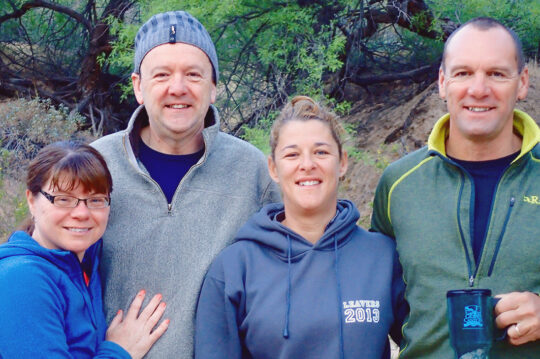 If your trip is in the early or late season (April/May or September/October), it is very important to bring additional warm clothing. These months tend to have cooler temperatures, cloudy skies, and the potential for storms. In addition to the items on the packing list, we recommend bringing layers including long underwear, fleece/warm pants, warm hat and gloves, warm socks, and neoprene socks/booties. Layering clothing under waterproof rain gear works well as being splashed by rapids on the river can make it feel much colder. We recommend having an additional set of warm, dry clothes, and maybe a puffy jacket for camp. We strongly suggest you bring these items and be happy if you don’t have to use them!
If your trip is in the early or late season (April/May or September/October), it is very important to bring additional warm clothing. These months tend to have cooler temperatures, cloudy skies, and the potential for storms. In addition to the items on the packing list, we recommend bringing layers including long underwear, fleece/warm pants, warm hat and gloves, warm socks, and neoprene socks/booties. Layering clothing under waterproof rain gear works well as being splashed by rapids on the river can make it feel much colder. We recommend having an additional set of warm, dry clothes, and maybe a puffy jacket for camp. We strongly suggest you bring these items and be happy if you don’t have to use them!
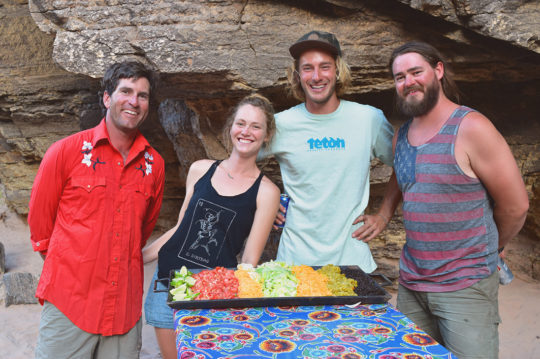 It is customary, upon receiving a satisfactory experience, to tip the river guides. It is an acknowledgement of a job well done and is greatly appreciated by the crew members. A common tip is 8-10% of the total river trip cost. You may leave cash or a check (bring a blank one to fill out on the river) with the trip leader, who will distribute it evenly among the crew. Please come prepared as you will NOT be able to tip with a credit/debit card nor apps like Venmo.
It is customary, upon receiving a satisfactory experience, to tip the river guides. It is an acknowledgement of a job well done and is greatly appreciated by the crew members. A common tip is 8-10% of the total river trip cost. You may leave cash or a check (bring a blank one to fill out on the river) with the trip leader, who will distribute it evenly among the crew. Please come prepared as you will NOT be able to tip with a credit/debit card nor apps like Venmo.
Morning
As the sun peeks over the canyon walls, you’ll hear a guide call “Coffee!” That’s your cue to head to the kitchen and grab a cup of joe and get ready for the day. A short while later, guides will call you to breakfast. Breakfast menus include traditional favorites such as made-to-order omelets, pancakes, French toast, sausage, and bacon. After breakfast, quickly finish packing up your campsite and personal gear and bring your bags to the rafts.
Once the guides have packed up the kitchen, everyone helps reload all the gear. Then you are off for a day of adventure on the mighty Colorado River!
On the River
As you start down the river, the serenity and beauty of the canyon capture you and the excitement builds as you anticipate running the first rapid of the day. Rain gear is a good idea for early morning rafting. Your day consists of running rapids, listening to canyon interpretation from your guides, and stopping for exploration of side canyons. Each guide has unique stories to tell about the canyon so make sure to switch rafts during your trip. Lunch is typically a quality deli spread. After lunch, the afternoon is filled with more rapids and spectacular scenery. You may take a hike, or sometimes two, as there are many incredible places to enjoy in the canyon. Hikes are to a variety of destinations: a beautiful vista, a stream or waterfall, an archaeological site, or a sandy beach to toss a Frisbee and enjoy some leisure time.
At Camp
In the late afternoon, you pull into camp and the rafts are unloaded by the group “duffel line”. Then you find your camp spot for the night – all camping gear is provided. You can set up a tent or sleep in the open air. The guides hustle to set up the kitchen and an important part of camp, the scenic bathroom area. Once your campsite is set up, enjoy sitting by the river or wander over to the kitchen for appetizers. Camp chairs are set near the kitchen area, so guests can chat and watch the river guides do their magic. Soon a fresh and delicious riverside meal will be ready for your dining pleasure! Dinner menus include hearty options such as grilled chicken, steak, and fajitas with fresh salads, side dishes and desserts.
As the day winds down, sit and watch a beautiful sunset, reflect on the day, or join in a conversation with other guests. At the end of the evening, head to your campsite for a restful sleep under a canopy of brilliant stars.
Please note: There is no exact itinerary of all the side hikes and camps that you’ll visit. Know that things are always changing. Many factors go into the guides’ decisions and can greatly impact what a normal day looks like including other groups, guest abilities, extreme conditions, and inclement weather.
Guests are sometimes surprised at how physical a river trip can be, but commonly say it was the best trip they’ve ever done. To help you prepare for your experience, here are some of the basic physical activities that are inherent to all of our Grand Canyon rafting trips.
Please remember, all guests must meet the minimum requirements outlined in the Essential Eligibility Criteria. There are many different trip types and factors that can make your experience more physically demanding. Keep in mind any factors such as medical and mental conditions, weight, age, lack of conditioning, dietary restrictions, addictions, allergies, and any other factors that might make your experience more difficult and/or dangerous to yourself or others. One of our primary goals is to run river trips as safely as possible. As this is a whitewater trip, you need to be able to be an active participant in your own rescue in case you end up in the river. It often surprises guests that most river trip injuries happen on land. Take your time, watch your step, ask for help if you need it, and don’t go beyond your limits. If you have any questions regarding physical ability please contact us.
River trips are awe-inspiring, fun, physical and a great way to challenge yourself. The thing to remember is, this is an adventure! The more you put into it, the more you’ll get out of it.
GET FIT FOR YOUR TRIP!
Want a fun way to get the most out of your trip? We teamed up with Jeff Schmelzle, a professional strength and conditioning specialist, to create an introductory-level program to help you get the most out of your trip. This simple program focuses on light exercise, balance, and stretching that you can do right at home.
Click here to download the Grand Canyon Rafting Fitness Program and get started today!
Note: The Preparation Program focuses on basic physical fitness for all of our trips. Guests on any trip that requires a hike in or out of the canyon or our Hiker’s Special trips need additional conditioning/training.
Many times each day, you’ll get on and off the rafts. This can be a challenging maneuver on both our motorized and oar-powered rafts. The rafts are roughly a 2-foot step up and can be slippery and moving; the ground will likely be uneven, sandy, and slippery. Once you’re on the raft, you’ll maneuver to your seat which could be over and around tubes, boxes, or other passengers.
The rafts will have straps in multiple locations to grip as you are going downriver. It’s important you find two handholds that will allow you to hold yourself in place and not be pitched one way or another. Pay attention to the guides’ instructions and keep your hand and feet out of pinch points on the rafts.
We rely on you to participate in the duffel shuffle each morning and evening when we arrive at our camping area. The guides depend on the group’s assistance to load/unload all guests’ bags, sleeping gear, and equipment. Some items are very heavy, like five-gallon buckets of water and propane tanks. All of that work is worth it once you’re settled in and enjoying dinner!
During the day all urine must go directly into the river, there are no toilets. This can be a very challenging aspect of the trip for some. Some people choose to wade into the river and others choose to squat at the river’s edge where there is very limited privacy.
While in camp, the guides will set up a camp toilet. Even with the toilet set up, peeing into the river or in our provided pee buckets is still encouraged. The toilet is often set well away from camp. The route to the toilet will likely be uneven, sandy, rocky, or brushy. It is recommended to scout your route to the toilet in the daylight.
This is a wilderness adventure! The weather, outdoor environment, and remote setting can bring their own set of challenges. You can expect to be exposed to prolonged sun, heat, cold, wind, rain, cold water, thunderstorms, and other weather-induced events. The Arizona sun can be intense. People often find they need to wear more sunscreen, cover-up, drink more water and eat more food and snacks in the canyon than they would at home.
Every trip provides the opportunity for hiking in side canyons along the river. These side hikes are optional and a unique part of a river trip. Hikes vary in length and difficulty. Some hikes may require moves that may feel more like rock scrambling than hiking and others may be short walks up a streambed. The more you prepare physically, the more you’ll be able to explore while on your trip.
Please note that some of our trip types do have a required strenuous 8 mile hike in or out of the canyon. Physical preparation is the key to a successful hike on these partial canyon trips.
Orientation Video
This video has helpful tips on what to expect during your adventure, how to care for yourself, your fellow trip members, and the Grand Canyon. Your river guides will also provide a detailed orientation specific to your trip type when you arrive.
You are about to embark on one of the most amazing expeditions of your life. Being part of a Grand Canyon rafting trip will challenge you in every way possible. Grand Canyon is a land of extremes; you will be hot/cold/wet/dry/happy/tired/in awe/sandy/relaxed, and ready for more.
Cameras/Phones
There is no WiFi or cell phone reception in the canyon. If you plan on using your phone as a camera, backup your data before you go and make sure you have lots of memory available. Put your phone in airplane/low power mode to save battery while on the trip. If you are using a camera and can bring additional memory and batteries, be sure to do so. We highly recommend bringing a portable charger or two. For more details, check out our blog on charging devices.
Securing a strap to your camera/phone is very helpful. A waterproof case doesn’t do any good if your camera or phone ends up at the bottom of the river. We recommend keeping your camera in a case even while in the provided dry bag (7” x 14” sealed). We have found that the fine Grand Canyon sand is as much of a danger to your camera as the water. Drones are prohibited per National Park Service rules.
Most personal homeowners’ insurance policies will not cover lost or damaged cameras on your river trip. If you bring items of value, it is your responsibility to provide your own insurance coverage. Arizona River Runners is not responsible for damage to or loss of personal items during river trips.
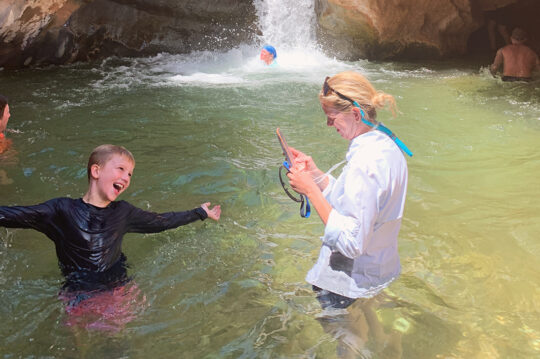
Beverages
We provide coffee, tea, and hot chocolate at breakfast. Water, electrolyte mix, and a variety of diet and regular soda are always available. If you only drink a certain brand (preferred soda, fruit juices, mixers, tonic, etc.), you may want to bring an additional supply as some choices run out. Since drinking water is not chilled, we recommend that you bring a hard plastic Nalgene-style water bottle so you can chill the water in the river. Insulated water bottles do not allow you to do this.
We do not supply alcoholic beverages, but you can bring your own. For info on how to get your booze on the trip, check out our blog. All beer must be in cans, not glass. Wine should be in boxes. Liquor in a glass bottle is acceptable, but plastic is preferred. Wine and liquor will be stowed by guides during the day and available in the evenings. Beer will be kept cool by the river and available during the day. Ice may be available in the evenings for cocktails.
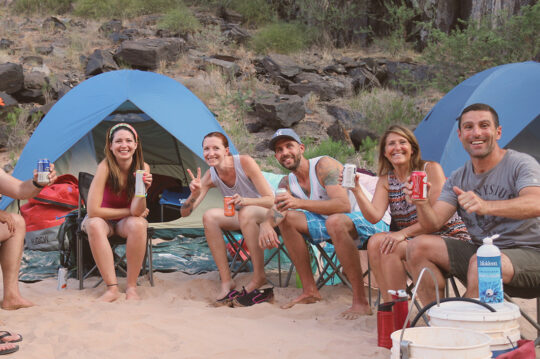
Fishing
Whether you are an amateur or avid fisherman, casting a line out into the mighty Colorado is a fun and enjoyable activity on a river trip. However, it does require some additional planning and equipment. Here are a few tips and tricks.
You may bring a small, collapsible fishing rod. You can fish from the shore but not while the raft is underway. You would be fishing mainly for trout. An Arizona fishing license must be purchased online prior to the trip.
Rod and reel/spin fishing: the best lures have been 1/4 oz to 1/8 oz gold spinners, fluorescent orange z-rays, small daredevils with a spot of orange or fluorescent red, and different colored worms. The Mepps Plain Lure Assortment Kit works great.
Fly fishing: the best setup is a San Juan Worm with a Zebra Midge tied to the hook, size 16-20. You can also use smaller nymphs or scuds.
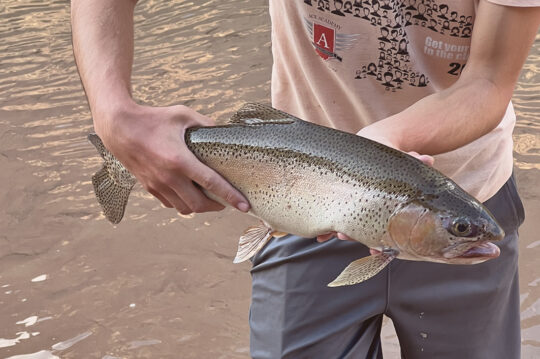
Camp Life
An important aspect of staying healthy while on-river is hydration. The arid environment requires that you drink more water and eat more salty snacks to maintain proper electrolyte balance. Being a desert environment flying insects aren’t usually a big problem, however, this can vary depending on the time of year and recent rains. If you are sensitive to bites you may want to plan accordingly and bring insect repellent and/or long sleeves and pants. Snakes and scorpions are rarely seen. If you do happen to spot any, give them space and notify a guide. You can reduce the possibility of an encounter with a critter even further by shaking out your shoes and PFD in the morning before putting them on and waiting until you are heading to bed to roll out your sleeping bag. Please be respectful of your fellow guests. Consider things like red lights on your headlamp, be thoughtful when using spray sunscreen, and know that marijuana is illegal as Grand Canyon National Park follows federal law.
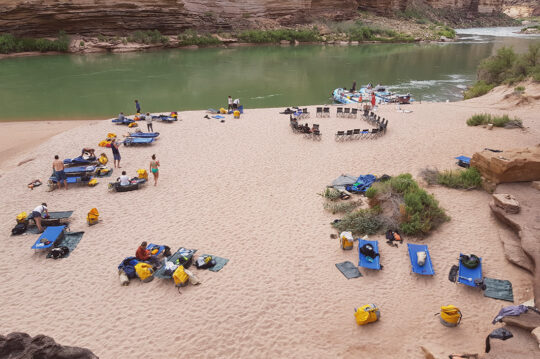
Hygiene
Because we’re like a big, close family throughout the river trip, keeping clean is an important factor in staying healthy. Guides will show you the hand-wash system and remind everyone to use it frequently. Soap is allowed only in the main river channel. Bathing in the cold water isn’t always appealing, so baby wipes are an easy alternative. You can’t use soap in or near the side streams but getting in the warmer, clearer water is refreshing and can help to keep you clean. We do NOT recommend bringing solar showers because they are difficult to store and very difficult to use on the river.
During the day, all urine must go directly into the river – that means squatting/standing near the river’s edge, wading in, or using a female urination device. There will be pit stops during the day, but if you have to go between stops, tell the guide before it’s an emergency so they have time to find a good place to pull over. If you need to poop during the day, the guides have a portable toilet system. Don’t be shy to ask for it if you need it. In camp, the guides will set up a camp toilet for solid waste while urine continues to go into the river. At night, we provide handy pee buckets so you don’t have to find your way to the river in the dark. In the morning, dump your pee bucket directly into the river. The guides will explain sanitation and bathroom procedures in greater detail during on-river orientation.
Ladies, if you might be on your period while on your river trip, it’s helpful to plan ahead and pack for the unexpected. If you will be using tampons, bring an outdoor menstrual kit or several discreet baggies and plenty of baby wipes. Make sure you keep these supplies handy during the day, in your provided day dry bag. When you change during the day, you can wrap the trash in a baby wipe, put that in a discreet baggie and dispose of it in the boat trash system or into the hygiene disposal at the camp toilet. Using pads is not the best option as you will get wet a lot on your river trip.
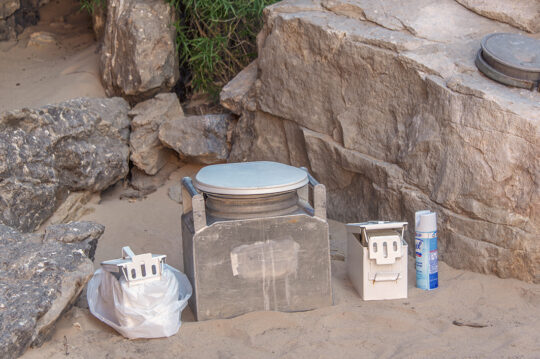
Weather
Weather can vary greatly during your trip. Humidity is usually very low, making the high temperatures less uncomfortable. River water temperatures typically range from 50-70°F depending on the time of year. Check the current river temperature here. Keep in mind that extreme weather (heat, cold, wind, rain, hail, flash flooding, etc.) can occur at any time with little to no advanced warning. Follow the packing list to be better prepared for a variety of conditions.
•April and May tend to be sunny with possible late-winter storms. Be prepared for cooler weather!
•June through mid-July is typically quite hot and sunny.
•Mid-July through mid-September is hot and mostly sunny with a strong chance of afternoon thunderstorms.
•Mid-September through October is usually warm and sunny with a chance of an early-winter storm. Be prepared for cooler weather!
How to check: Take a look at our weather blog for links to weather forecasts in the canyon and tips on how to pack accordingly.
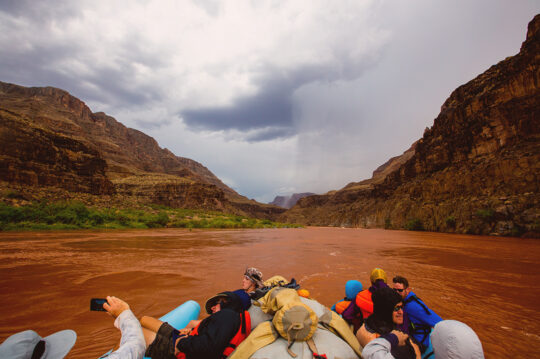
Medical and Dietary Considerations
Due to the remote nature of the trip, it is important to understand that access to professional medical care can take several hours or even overnight. If you or someone in your group has any physical, medical or mental conditions, dietary restrictions or allergies, please list this information on your registration form and notify our office as soon as possible. We strongly encourage you to talk to a doctor and take any necessary precautions. Although we can often make modifications for customers who have food allergies, we want you to understand that we cannot guarantee 100% safeguard from exposure to your allergen. Be sure to bring your required medications, including EpiPens, on the trip.
Multi-day river trips are active, outdoor adventures and can be challenging. Extreme weather, cold river water, and other factors add to the intensity. Please see your acknowledgement of risk form for additional potential risk factors. If you have essential prescription medication, it is advisable to split your medication into two waterproof containers ahead of time so you can keep half and give half to the trip leader for backup storage. Be sure to clearly label all containers. If you have any questions regarding your ability to participate in this trip, please consult your doctor and call our office so that we may help answer your questions.
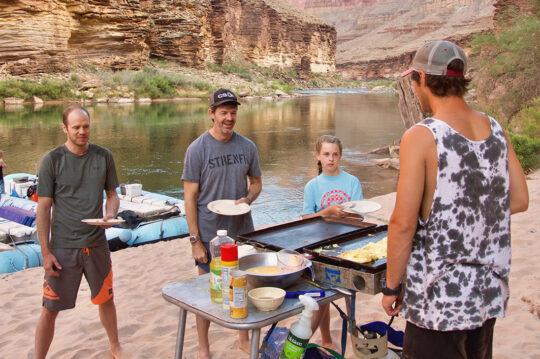
Emergency Information
One of the benefits of a river trip in Grand Canyon is the rare opportunity to be disconnected. There is no cell service or WiFi. We do carry satellite communication devices, but they are only used for outbound messages in the event of an emergency on the river. These devices remain turned off and are not used for incoming messages/calls. In the unlikely event that we could get a message to our guests, there are almost no options to leave the trip and exit the canyon, even if there is an emergency at home. We think it is important to discuss with your family ahead of time whether you would want to receive news of an emergency or death while on the river, as there will likely be nothing you can do until the end of your trip. Feel free to share our office number with your family so that they can reach us while you’re away.
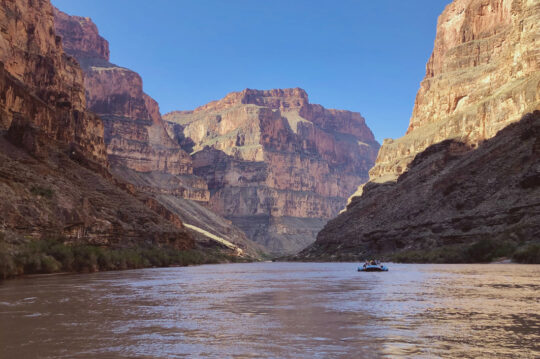
Risk
Our experience through the years has shown that river rafting trips are fun vacations. You should recognize, however, that there is an element of risk in any adventure or activity associated with whitewater rafting and the outdoors. Check with your local agent concerning your insurance needs. The Visitor’s Acknowledgement of Risk form must be understood and signed by each passenger 18 years and older. Minors must have a parent/legal guardian sign for them. Each spouse must sign individually; one cannot sign for the other.
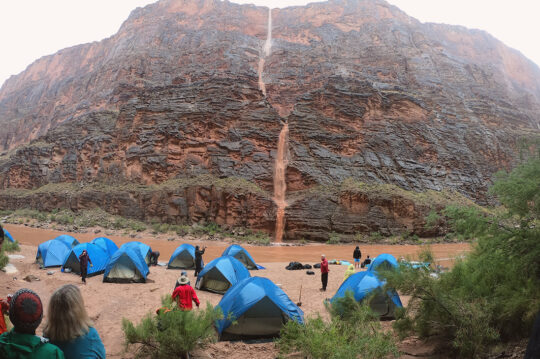
Travel Protection
ARR highly recommends that you purchase travel insurance after making the initial deposit for your river trip. No one ever plans to cancel their Grand Canyon river trip. But, believe us, unpredictable situations arise like family illness/injury, flight delays, etc. Look for additional benefits like trip interruption, emergency medical expenses, trip delay, baggage delay, etc. Make sure your coverage includes all your travel dates, and not just your rafting trip dates. We suggest Travelex Insurance Services for U.S. residents; international guests, please research your insurance options. It is your responsibility to choose the policy that works for you. Go to Travelex Insurance Services or call 800.228.9792 for more info. Use Reference Code 03-0131
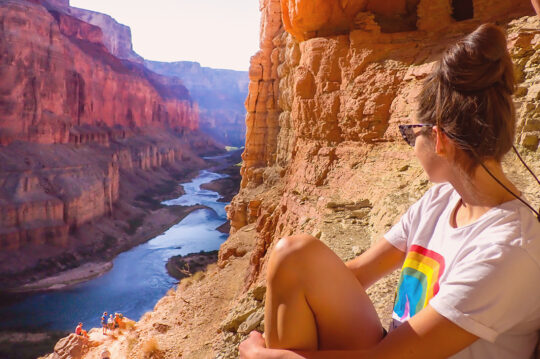
Rafting Trip Policies
It’s important for everyone in your party to understand our trip policies – including our Cancellation Policy.

